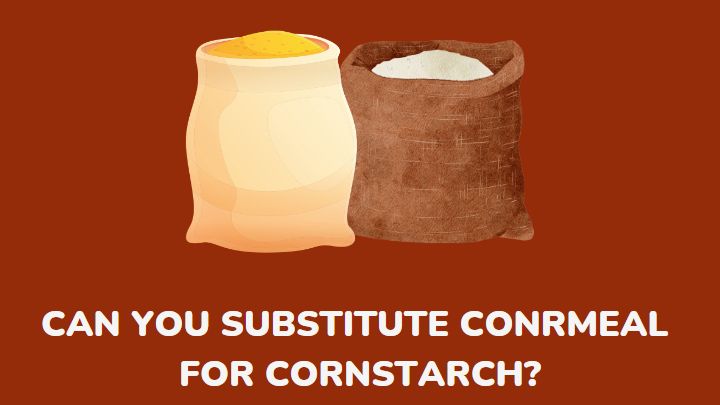Cornmeal and cornstarch are both corn products and are often mistaken for each other. Although they are both gotten from corn, you cannot substitute cornstarch with cornmeal, nor the other way around.
They have different uses, textures, and colors. Cornstarch is used when making sauces, soups, and pastries. Cornmeal is used to make dishes like polenta and cornbread.
This article explains what cornmeal and cornstarch are, their differences, their uses, and their substitute. All of these will help you understand why they can’t serve as substitutes for each other.
What is cornmeal?
Cornmeal is a coarse flour obtained by grinding dried field corn. It could be yellow or white, depending on the color of the corn. The texture can be anywhere between fine and coarse.
Coarser cornmeal is richer in nutrients than other variants. For instance, stone-ground cornmeal which is the coarsest type of cornmeal contains some hull and germ which makes it richer in nutrients.
Fine cornmeal doesn’t contain any hull or germs and is usually ground in between metal rollers. It loses nutrients while processing, but the nutrient can be added back later.
What is cornstarch?
Cornstarch is a white refined powder made from the starchy portion of corn kernels known as the endosperm. It serves as a thickening agent for gravies, sauces, soup, casseroles, and the like.
Cornstarch is stripped of protein and fiber, thereby making it gluten-free and tasteless. This makes it perfect for thickening sauces, gravies, soup, and stews.
Cornmeal vs cornstarch
1. Uses
Cornmeal is a multifunctional pantry staple. Fine and medium cornmeal is great for making pancakes and soft, buttery cornbread.
Coarse cornmeal is used to make creamy polenta and grits. It is also used in sweets, cookies, puddings, and madeleines.
On the other hand, cornstarch is used to thicken soups, stews, gravies, and sauces. It helps the loose mix of pie fillings and pizza to hold up well together.
2. Color and texture
Cornmeal can be fine, medium, or coarse. It can be yellow or white. There’s also a rare blue variant that is found in the indigenous part of southern America.
Cornstarch has a very fine, powdery texture and is usually white and chalky in appearance.
3. Nutrient
Cornmeal has enormous nutritional benefits which vary depending on the texture. Coarse cornmeal usually has more carbohydrates, protein, fat, and calories than fine grains.
However, refined cornmeal is often infused with nutrients after grinding to make them more nutritional than coarse grains.
Cornstarch has little or no protein or fat just carbohydrates.
4. Flavor
Unlike cornstarch, cornmeal has a powerful corn taste that’s bound to be obvious when added to food. Yellow cornmeal has a more dominating taste than white cornmeal but fine cornmeal is milder in taste.
Cornstarch, on the other hand, adds little or no taste to food.
Cornstarch substitutes
Now that you understand that you cannot substitute cornmeal for cornstarch, what then can serve as substitutes?
Below are some alternatives that can serve as thickening agents in your food:
1. Arrowroot flour
This is starchy flour extracted from the roots of the Maranta genus of plants found in the tropics. Plant roots are dried and ground into fine powder to make an arrowhead.
Compared to cornstarch it contains more fiber and is great for thickening clear liquid. To get the same level of thickening as cornstarch, you’d need twice as much arrowroot in your food.
2. Potato starch
This is an excellent alternative to cornstarch. Potato is usually crushed so that it can release its starch content and dried afterward to become powder.
It contains no gluten nor adds unwanted flavor to your food. Unlike cornstarch, it has some elements of fat and protein.
Potato starch is as strong as cornstarch and can substitute cornstarch in a one-to-one ratio. Do not cook potato starch too long because it thickens fast.
3. Tapioca
Extracted from cassava, tapioca is cassava root ground into a pulp. After grinding, the water from the cassava is filtered to remove the toxic cyanide present. Afterward, it is dried to powder.
Tapioca is strong enough to substitute cornstarch in a two-to-one ratio. You can get tapioca in flour, pearls, or flakes form.
4. Wheat flour
Wheat flour is wheat ground into a smooth powder. It contains high carbohydrates and a substantial amount of protein and fiber.
However, you’d need twice as much wheat flour to replace cornstarch in your recipe. Also, you have to mix wheat flour with a little cold water into a paste before using it as a thickening agent. Keep in mind that wheat flour is not gluten-free.
FAQs
Can you add cornmeal to soups?
No. Cornmeal has a pronounced corn flavor and will significantly alter the taste and flavor of your soup.
What can substitute cornmeal for frying?
You can coat meat and fish in corn flour before frying as an alternative to cornmeal.
Is cornmeal the same as corn flour?
Cornmeal is different from corn flour. Corn flour is a fine, white, and tasteless flour. In contrast, cornmeal could be fine or coarse. It could be white, yellow, or blue and it has a rich corn taste.
Is cornstarch corn flour?
No. Cornstarch and corn flour are two different corn products. Corn flour is gotten by grinding whole corn kernels while cornstarch is gotten from the starchy part of the corn.
Conclusion
Cornmeal and cornstarch are two different pantry staples that cannot substitute for each other. Cornstarch is used to thicken loose food, making them hold up well. It is used to thicken stews, sauces, soup, pizza or pie crust, and gravies.
While cornmeal is a major ingredient used for making cornbread, polenta, and the like. In addition, cornmeal, cornstarch, and corn flour are three different by-products of corn.
I hope this article helped. Thanks for reading.
Check Millenora for more articles on comparison and ingredient substitution.
